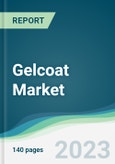The gelcoat market was valued at US$1,260.217 million in 2021.
Gelcoat is a material used primarily in the manufacturing of fiberglass-reinforced composites. It is a specialized material applied to the surface of a composite material to provide a smooth, glossy finish and protect the underlying structure from environmental damage. It is widely used in various industries, including aerospace, automotive, marine, construction, and wind energy. It is used to produce multiple products, such as boats, aircraft, wind turbine blades, swimming pools, and automotive parts. The demand for gelcoat is largely driven by the growing demand for lightweight and high-performance materials in various industries. The increasing demand for fuel-efficient vehicles and renewable energy sources has also led to the adoption of composites, which has driven the demand for gelcoat. The gelcoat market is highly competitive, with many players operating at both global and regional levels. Key players in the industry include Ashland Inc., BASF SE, and Aliancys AG. These companies are investing heavily in research and development to develop new and innovative products to meet the changing needs of their customers.The gelcoat market is driven by growth in the marine industry and technological advancements in gelcoat manufacturing.
Growth in the marine industry:
The marine industry is a significant consumer of gelcoat, primarily in producing boats and yachts. The increasing popularity of boating and yachting activities, particularly in emerging markets, is expected to drive the growth of the gelcoat market. The National Marine Manufacturers Association (NMMA) reports that the recreational boating industry in the U.S. generated an estimated US$42 billion in sales in 2020, an increase of 9% compared to the previous year.Technological advancements and research in gelcoat manufacturing:
Manufacturers of gelcoat are investing heavily in research and development to improve the performance and properties of their products. This has led to the development of new and innovative gelcoat formulations that offer better adhesion, resistance to water, and UV stability. This driver is expected to fuel the growth of the gelcoat market in the future. The U.S. Department of Defense's Defense Advanced Research Projects Agency (DARPA) has invested in developing advanced composite materials, including gelcoat, in improving their performance and durability.Market Developments:
- In March 2020, Scott Bader, a UK-based materials science company, introduced its range of adhesive, resin, gelcoat, and tooling products at the JEC World event. The company launched Crestafire, its composite FST system that meets the stringent European and global FST standards and is suitable for the rail, marine, building, and construction markets. Visitors to the stand can see an internal passenger train door manufactured using Scott Bader's Crestapol 1211 urethane acrylate resin and Fireguard gelcoat 78PPA. The adhesive ranges include Crestabond, Crestomer structural adhesives, and Crestafix bonding pastes. Additionally, the company introduced Crystic Ecogel ultra-low styrene spray gel coats, Crestapol resins for lightweight carbon fiber components, and Crestamould matched tooling systems.
The construction segment is expected to witness modest growth over the forecast period.
The construction industry is one of the major end-use industries for gelcoat, which provides a protective layer and aesthetic finish to surfaces such as walls, floors, and roofs. Gelcoat is widely used in the construction of residential and commercial buildings, as well as in infrastructure projects such as bridges and tunnels. One of the drivers of the gelcoat market in the construction industry is the increasing demand for sustainable and durable construction materials. Gelcoat offers a durable and long-lasting protective layer that can withstand harsh weather conditions, UV rays, and other environmental factors, reducing the need for frequent maintenance and repairs. Moreover, the growing trend of using composites in construction, such as fiberglass reinforced plastic (FRP), is also boosting the demand for gelcoat. Gelcoat is used as the topcoat in FRP composites to provide a smooth and aesthetically pleasing finish while protecting the underlying material from corrosion and damage.Additionally, the increasing demand for green buildings and energy-efficient construction is driving the use of gelcoat in constructing roofs and walls. Gelcoat can be formulated to reflect sunlight and reduce heat absorption, helping to reduce energy costs and improve energy efficiency.
North America accounted for a significant share of the global gelcoat market.
Based on geography, the gelcoat market is segmented into North America, South America, Europe, Middle East and Africa, and Asia Pacific. The North American gelcoat market is expected to witness significant growth during the projected period, driven by the increasing demand for gelcoat in the marine industry. The United States is the largest market for gelcoat in North America due to the presence of many boat and yacht manufacturers in the country. In addition, the use of gelcoat in wind energy applications is also driving market growth in the region. Furthermore, the increasing demand for lightweight materials in the automotive industry is also driving the demand for gelcoat in North America. Gelcoat is used to produce lightweight composite parts for automobiles, providing a smooth and durable finish while reducing the overall weight of the vehicle.Market Segmentation:
By RESIN TYPE
- Polyester
- Epoxy
- Vinyl Ester
- Others
By END-USER INDUSTRY
- Transportation
- Construction
- Wind Energy
- Marine
- Others
By GEOGRAPHY
- North America
- USA
- Canada
- Mexico
- South America
- Brazil
- Argentina
- Others
- Europe
- Germany
- France
- United Kingdom
- Spain
- Others
- Middle East And Africa
- Saudi Arabia
- UAE
- Israel
- Others
- Asia Pacific
- China
- Japan
- India
- South Korea
- Indonesia
- Thailand
- Taiwan
- Others
Table of Contents
1. INTRODUCTION
2. RESEARCH METHODOLOGY
3. EXECUTIVE SUMMARY
4. MARKET DYNAMICS
5. GELCOAT MARKET BY RESIN TYPE
6. GELCOAT MARKET BY END-USER INDUSTRY
7. GELCOAT MARKET BY GEOGRAPHY
8. COMPETITIVE ENVIRONMENT AND ANALYSIS
9. COMPANY PROFILES
Companies Mentioned
- Ineos Enterprise
- Bufa Composite Systems GmbH
- HK Research Corporation
- Allnex
- Scott Bader Company
- Poliya Composites Resins and Polymers
- Interplastic Corporation
- Alpha Owens Corning (AOC) Aliancys
- Polynt-Reichhold Group
- Turkuaz Polyester
Methodology

LOADING...








